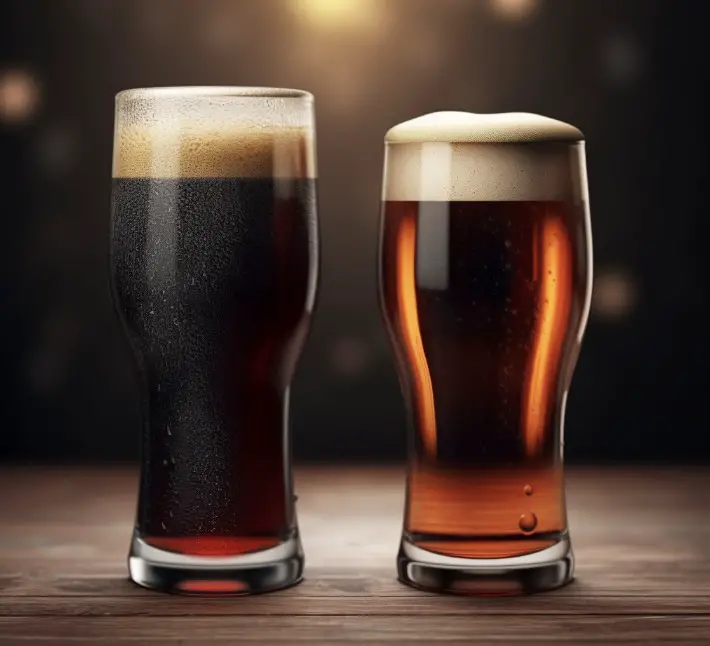As a passionate home brewer, I have had the pleasure of crafting and tasting various styles of beer, and it never ceases to amaze me how diverse and unique each type can be. Two beer styles that are often misunderstood and confused are stouts and ales.
Stouts are the darkest of ales due to the use of darker malt types and stouts often have pronounced coffee or chocolate notes, while ales in general can vary greatly in color and flavor, ranging from light and fruity to dark and malty.
The main difference between stouts and ales lies in the type of malt used in brewing, the color, the aroma, and the flavors they exhibit.
In this post, I’ll delve into the detail about the differences between these two styles, touching on their appearance, taste, smell, and brewing techniques. By the end, you’ll have a better understanding of what sets these two styles apart and why they’re loved by so many.
A brief history of stouts and ales
Before diving into the differences between stouts and ales, it’s important to know their origins and how they came to be.

Ales
Ales have been around for thousands of years and are one of the oldest types of beer. They originate from ancient Mesopotamia and Egypt, where they were brewed using a warm fermentation process. The term “ale” comes from the Old English word “alu” or “ealu,” which means beer.
Stouts
Stouts, on the other hand, have a shorter history, dating back to the 18th century in England. They were initially called “stout porters,” as they were a stronger version of porter beers. The word “stout” was used to describe their strength and higher alcohol content. Over time, stouts evolved into their own distinct style, with the porter name being dropped altogether.
Ingredients
The key ingredients in both stouts and ales are water, malted barley, hops, and yeast. However, the specific types of malt and hops used can vary significantly between these two beer styles, resulting in their distinct flavor profiles.
Stouts typically use roasted barley and darker malts, which impart a rich, dark color and robust flavor to the beer. These malts also contribute to the characteristic roasted, chocolate, or coffee notes often found in stouts.
Ales, on the other hand, can be brewed with a wide range of malted barley, from pale malts to caramel and specialty malts. This allows for a more diverse array of flavors and colors in ales, ranging from light and crisp to malty and sweet.
The role of malt in stouts and ales
One of the key differences between stouts and ales comes down to the type of malt used in brewing.
Malt is one of the four main ingredients in beer, alongside water, hops, and yeast. It’s responsible for providing the sugars that yeast ferments into alcohol and contributes to the beer’s color, aroma, and flavor.
Malt plays a crucial role in the production of stouts and ales, as it provides the primary source of fermentable sugars and contributes to the flavor, color, body, and overall character of these beers.
- Fermentable Sugars: Malt contains enzymes that convert the starches present in barley into fermentable sugars, primarily maltose. During the brewing process, these sugars are extracted from the malt through mashing and then fermented by yeast, producing alcohol and carbon dioxide.
- Flavor: Malt imparts a wide range of flavors to stouts and ales. Different malts can contribute varying degrees of sweetness, caramel, toffee, breadiness, roastiness, chocolate, coffee, nuttiness, and even fruity or spicy notes. Brewers can choose from a diverse selection of malt varieties to achieve the desired flavor profile in their beers.
- Color: Malt also influences the color of stouts and ales. Lighter malts, such as pale or Pilsner malts, produce lighter-colored beers, while darker malts like roasted barley or chocolate malt can give stouts their characteristic dark color. The degree of roasting or kilning of the malt determines the intensity of the color contribution.
- Body and Mouthfeel: Malt provides the fermentable sugars that yeast converts into alcohol, but it also contributes unfermentable sugars, proteins, and other compounds that influence the body and mouthfeel of the beer. Stouts and ales often have a fuller, more substantial mouthfeel, and this is partially attributed to the malt content.
- Specialty Malts: Brewers often use specialty malts to add complexity and uniqueness to stouts and ales. These malts include crystal malt, roasted malt, black malt, wheat malt, rye malt, and others. They offer specific flavors and contribute to the overall character and depth of the beer.
It’s worth noting that while barley is the most commonly used grain in brewing, other grains like wheat, rye, oats, and corn can also be utilized, either as adjuncts or as a substantial portion of the grain bill, to create different styles of stouts and ales.
Malt used in Ales and Stouts
The malt used in stouts is typically roasted to a much higher degree compared to the malt used in ales, which contributes to the unique characteristics of stouts.
Stouts, however, rely heavily on dark roasted malts, such as chocolate malt, black malt, or roasted barley. These malts give stouts their characteristic dark color and impart flavors of coffee, chocolate, and roasted grains.
Here are some key differences between the malt used in stouts and ales:
- Roasting Level: The malt used in stouts undergoes a more extensive roasting process than the malt used in ales. This results in a darker color and deeper flavors in stouts. The roasting process can range from lightly toasted to heavily roasted, creating a wide spectrum of flavors and colors.
- Flavor Profile: The heavily roasted malt used in stouts imparts rich, roasted, and sometimes even burnt flavors. These flavors can include chocolate, coffee, toffee, caramel, and even hints of smoke. The malt used in ales, on the other hand, tends to have a milder and more balanced flavor profile.
- Color: Stouts are known for their dark appearance, ranging from deep brown to black. This dark color is achieved by using highly roasted malt. Ales, on the other hand, can vary in color from pale gold to amber or even darker hues, depending on the specific style.
- Body and Mouthfeel: The malt used in stouts contributes to a fuller body and smoother mouthfeel. The higher degree of roasting can create a perception of greater viscosity, giving stouts a thick and creamy texture. Ales, depending on the style, can have a range of body and mouthfeel characteristics, but they generally tend to be lighter and more effervescent than stouts.
- Usage in Brewing: Stouts often rely on roasted barley, a highly roasted malt, to achieve their distinctive flavors and colors. In contrast, ales typically use a variety of malts, including pale malts for base flavor and color, as well as specialty malts for additional complexity.
It’s important to note that the terms “stout” and “ale” refer to broad categories of beer styles, and there can be variations within each category.
The specific malt selection and brewing techniques can vary widely, leading to a diverse range of stouts and ales with their own unique characteristics.
Overall, malt is a fundamental ingredient in the brewing process, providing fermentable sugars, flavors, color, body, and mouthfeel to stouts and ales. The choice of malt and its processing greatly influences the final character and quality of these beers.
The brewing process
While the basic brewing process is similar for both stouts and ales, there are some differences in the techniques and ingredients used.
Ales
Ales are top-fermented beers, meaning the yeast used in fermentation rises to the top of the fermentation vessel. Ale yeast strains work best at warmer temperatures, typically between 60°F and 72°F (15°C and 22°C). This warmer fermentation results in the production of fruity esters and other flavor compounds that give ales their characteristic flavors.
Stouts
Stouts are also top-fermented, but as mentioned earlier, they rely on dark roasted malts for their color and flavor. The brewing process for stouts may include a longer mash time to extract more color and flavor from the grains or a higher mash temperature to create a richer, fuller-bodied beer.
Appearance
One of the most noticeable differences between stouts and ales is their appearance, particularly their color.
Ales
Ales can vary greatly in color, from pale straw to amber to deep brown. The color is determined by the type and amount of malt used in the brewing process.

Stouts
Stouts, on the other hand, are almost always dark in color, ranging from deep brown to jet black. This dark color is the result of the dark roasted malts used in brewing.
Aroma
The aroma of a beer can provide clues to its style, and this is certainly true for stouts and ales.
Ales
Ales often exhibit fruity, floral, or spicy aromas from the esters and phenols produced during fermentation. Depending on the malt and hops used, an ale may also have aromas of caramel, toffee, or biscuit.
Stouts
Stouts typically have a roasty aroma, with notes of coffee, chocolate, or toasted bread. Some stouts may also have a slight sweetness or a hint of dark fruit in the aroma.
Flavor
While both stouts and ales can be diverse in flavor, there are some common characteristics that set them apart.
Ales
Ale flavors can range from light and fruity to dark and malty, depending on the malt and hops used. Common flavors in ales include citrus, stone fruit, berries, caramel, toffee, and biscuit.
Stouts
Stouts are known for their roasty, coffee-like flavors, often accompanied by notes of chocolate and caramel. Some stouts may also exhibit flavors of dark fruit, such as raisins or plums.
Mouthfeel
The mouthfeel of a beer refers to the way it feels on the palate, including its body, carbonation, and texture.
Ales
Ales can have a wide range of mouthfeels, from light and crisp to rich and creamy. The mouthfeel is influenced by factors such as the malt and hops used, the yeast strain, and the brewing techniques employed.
Stouts
Stouts generally have a fuller body and a creamier texture compared to ales. This can be attributed to the higher mash temperatures used in brewing, which result in more unfermentable sugars and a richer mouthfeel.
Food Pairings
Both stouts and ales can be excellent choices for pairing with food, but their distinct flavor profiles lend themselves to different types of dishes.
Stouts, with their rich, robust flavors, pair well with hearty, savory dishes like roasted meats, stews, and strong cheeses. Their smooth, creamy mouthfeel also makes them a great match for desserts like chocolate cake or ice cream.
Ales, with their more diverse range of flavors, can complement a variety of dishes, from light salads and seafood to grilled meats and spicy dishes. Pale ales and IPAs, with their hoppy bitterness, can cut through the richness of fried foods, while malty amber ales can complement caramelized, roasted flavors in dishes like barbecue.
Popular Stout and Ale Styles
There are many different styles of stouts and ales, each with their own unique characteristics and flavor profiles.
Some popular stout styles include:
- Dry Irish Stout
- Sweet or Milk Stout
- Oatmeal Stout
- Imperial Stout
Some popular ale styles include:
- Pale Ale
- India Pale Ale (IPA)
- Amber Ale
- Brown Ale
- Barleywine
Conclusion
In conclusion, the main differences between stouts and ales lie in the type of malt used, the color, the aroma, and the flavors they exhibit. Stouts are typically dark, roasty, and often have coffee or chocolate notes, while ales can vary greatly in color and flavor, ranging from light and fruity to dark and malty.
To recap, here are 10 key facts about stouts and ales:
1. Ales have a longer history, dating back thousands of years, while stouts originated in the 18th century.
2. Ales can be brewed using various malt types, resulting in a wide range of colors and flavors.
3. Stouts rely on dark roasted malts for their characteristic dark color and roasty flavors.
4. Both stouts and ales are top-fermented beers.
5. The brewing process for stouts may include a longer mash time or higher mash temperature.
6. Ales can vary greatly in color, while stouts are almost always dark.
7. Ales often exhibit fruity, floral, or spicy aromas, while stouts have a roasty aroma.
8. Ale flavors can range from light and fruity to dark and malty, while stouts are known for their coffee-like flavors.
9. Ales can have a wide range of mouthfeels, while stouts generally have a fuller body and creamier texture.
10. Both stouts and ales offer a diverse range of flavors and aromas, making them favorites among beer lovers worldwide.
FAQs
What makes stout different from beer?
Stout is a type of beer that is typically darker and more robust in flavor than other beers, with a higher alcohol content and a creamy, smooth texture. It is often made with roasted barley, which gives it its distinctive color and flavor.
Is stout an ale or a beer?
Stout is a type of beer, specifically a dark beer that is made using roasted malt or barley.
Does stout count as beer?
Yes, stout is a type of beer. It is a dark, roasted beer that is typically made with malted barley, hops, water, and yeast.
Is stout considered a beer?
Yes, stout is considered a type of beer. It is a dark, roasted ale that typically has a higher alcohol content and a rich, full-bodied flavor.
What makes stout unique?
Stout is unique due to its dark color, roasted flavor, and creamy texture, which comes from the use of roasted barley and a higher percentage of hops than other styles of beer. Additionally, stouts often have a higher alcohol content and are known for their complex flavors and aromas, which can include notes of coffee, chocolate, and even smoke.
Why is a stout not a beer?
A stout is actually a type of beer, specifically a dark beer brewed as an ale that is typically made using heavily roasted barley.




